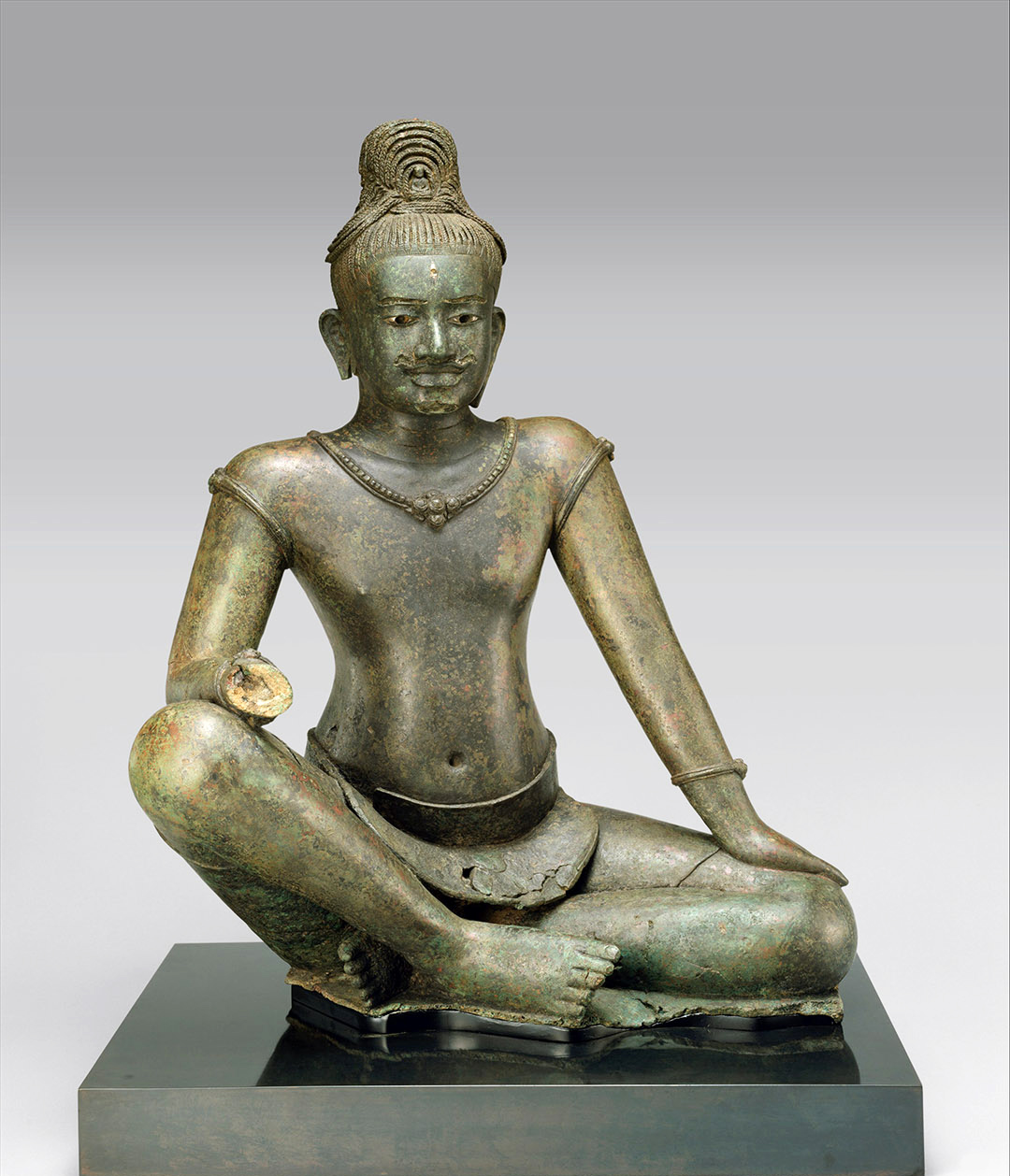
Administrators
•
•
The middle cabinet of displayed bronzes at the National Museum in Phnom Penh, recently installed to celebrate the 75th anniversary of diplomatic relations between the USA and Cambodia, holds 2 exhibits that were part of a group of fourteen pieces that were returned by the Metropolitan Museum of New York in July 2024. The Met realized that the provenance for the 14 items was very dodgy, in non-technical terms, and decided to do the right thing. The larger of the two is a magnificent image of a seated Lokeshvara in the elegant Baphuon style of the eleventh century, depicted in the king-like royal ease posture and considered by experts as one of the finest and most important surviving large-scale bronze sculptures from the Angkor period. It found its way to The Met in 1992, sold to the museum by none other than Douglas Latchford, a name synonymous with the systematic looting of Khmer-era temples across Cambodia and Thailand for more than fifty years. It was the looter-turned-informer, Toek Tik, who said he unearthed the bronze statue using a metal detector around 1990. He stowed the bronze in a backpack and took it to Siem Reap where he sold it to a trafficker, known to Cambodian authorities as Sleeping Giant, who worked for Latchford. Photographs on Latchford’s own computer show the dirt-encrusted statue undergoing restoration in a workshop prior to its sale to The Met. It was featured by Latchford and Emma Bunker in their 2011 scholarly book, Khmer Bronzes.
The sculpture’s coiffure is formed by elegantly arranged loops of braided hair with a tiny Amitabha Buddha seated in the front, confirming the image as representing the Bodhisattva Avalokiteshvara (better known in Cambodia as Lokeshvara). The deity wears a simple plain sampot with an over-fold and is adorned with a discreet set of jewelry including armlets, bracelets and a necklace with a rumduol flower pendant. The only visible damage is a missing right hand and a broken ear lobe. Broad incisions marking the eyebrows, moustache, chin and a third eye would’ve been inset with silver and obsidian, while his eyes were inlaid with crystals, giving the image a sense of inner life. The relaxed secular pose and distinctive individual appearance suggest that the image represents the spiritual identity of a member of the elite class in the guise of Lokeshvara, reflecting a custom associated with indigenous Khmer cults of ancestor worship. This custom culminated in the images of Jayavarman VII’s deceased first queen, reflected in statues of Prajnaparamita, in both bronze and stone, in the latter part of the twelfth-century. The years-long project by EFEO and Apsara Authority in uncovering the presence of a bronze-making foundry in the Royal Palace area of Angkor Thom has breathed life into the possibility that such elegant bronzes were made inside the royal city itself. A suggestion that the image may’ve originated from Prasat Beng in Phnom Srok district in Banteay Meanchey province is yet to be verified.
The Met made the unexpected announcement to deaccession the 14 Khmer images in December 2023, marking a major U-turn on their previous policy of ignoring Cambodia’s claims for repatriation, and instead cooperated with the U.S. Attorney's Office, Southern District of New York and Homeland Security Investigations in sending back antiquities specifically linked to Douglas Latchford. The second smaller bronze is this remarkable face of Shiva, with a faintly menacing thousand-yard stare, a bronze mask that once adorned a life-size sculpture of the Hindu god inside a sacred temple, but suffered the fate of too many beautiful bronze statues that were either stolen, broken into pieces or melted down. This fragment adds weight to the Khmers’ ability to produce large-scale bronze sculptures in Angkor from the tenth century. We have seen a series of incredible bronze statues from the next century, during the Baphuon-era, and a similar face and head from that period is in the National Museum of Cambodia’s collection. For the Met’s Shiva face, the eyebrows are formed by a single ridged line and a narrow moustache with curvy tips is depicted above lightly rimmed lips. The eyeballs (and third eye) are marked by empty sockets that were probably inlaid with obsidian and silver used for the whites of the eyes. The damage to the hair and crown leaves us guessing at its style. The only public provenance issued by The Met is that the bronze face was donated to the museum by Douglas Latchford in 1998, to mark the thirty-plus year tenure of Martin Lerner, as their South & Southeast Asian art curator. Where Latchford obtained the bronze is a missing piece in the jigsaw.Credit By :Andy Brouwer
#Moha Nokor


0 comment
 Monks
Monks

 Group
Group Buddha Dhamma Monk
Buddha Dhamma Monk Puthichak IT
Puthichak IT buddha dharma monk
buddha dharma monk  BuddhaChak IT
BuddhaChak IT  Cambodia4World
Cambodia4World  Bokator Cambodia
Bokator Cambodia  Monk Cambodia
Monk Cambodia Economic Buddhism
Economic Buddhism  Lbokator Khmer
Lbokator Khmer  Housewife Khmer
Housewife Khmer  Kun Lbokator
Kun Lbokator Preap News
Preap News  Sampeah News
Sampeah News  Kampuchea Chef
Kampuchea Chef 

























































